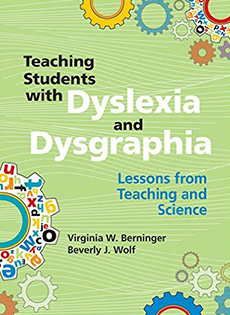What is Dysgraphia?
More commonly known as “written expression learning disorder,” dysgraphia is a learning disability that involves difficulty with written expression. Dysgraphia can cause issues with spelling, handwriting, and translating thoughts to paper.1
Students with dysgraphia may struggle to form letters, numbers, and words by hand, and may also have trouble thinking and writing at the same time. In more severe cases, the student may be unable to hold a pencil correctly or draw a straight line.1
- 1 in 5 Children have difficulty expressing themselves through writing2
- 75% Of children with dysgraphia are male3
- 66% Of people don’t know about dysgraphia4
Early signs of dysgraphia
- Better at communicating through speech than through writing1
- Tight or awkward pencil grip1
- When writing, says words out loud or carefully watches hand1
- Tires easily when writing by hand
- Hands are sore when they finish writing
- Body position is awkward or eyes are too close to the paper
- Illegible handwriting
- Uneven spaces between letters and words on paper, or difficulty writing within lines and margins1
- Incorrect orientation of letters (either vertically or horizontally)1
- Trouble with tasks that require thinking and writing at the same time, such as notetaking1
What to Do if You Notice Signs of Dysgraphia
Take Notes
If your child struggles to express ideas through writing or shows difficulty with handwriting, begin making notes of your specific concerns. The more information you have, the better assessment a professional can make.
Talk to Your Child’s Teacher
If you notice any of the signs of dysgraphia, talk to your child’s teacher about his or her performance in class. Bring up your specific concerns and ask about the progress your child has made with handwriting over the course of the school year.
Request an Evaluation
A full educational evaluation will pinpoint the specific writing issues your child may be struggling with. Talk to your child’s teacher to see if he or she qualifies for testing through the school, or schedule a session with a private evaluator.
Be Proactive and Trust Your Gut
Trouble with writing can be falsely attributed to laziness or lack of motivation. That means gifted children with dysgraphia often go undiagnosed and miss out on opportunities to address the real issue. As a parent, you are your child’s number one advocate, and it’s never too early to evaluate a potential writing issue.5
What to Do if Your Child is Diagnosed with Dysgraphia
Find a Specialist
Students with dysgraphia need ongoing, explicit instruction in handwriting, spelling, and composition, but many schools do not offer these services. Look for professionals with full certification and continued professional development related to dysgraphia. Students with dysgraphia respond well to multisensory approaches that use auditory, kinesthetic, and tactile senses, such as the Wilson Reading System®.
Request Classroom Accommodations
Talk with your child’s teachers about making small changes in the classroom to help your child succeed. For example, ask the teacher to:
- Allow your child to use pencil grips and other writing aids
- Let your child use a keyboard, tablet, or other technology as a substitute for written expression so they can focus on the ideas rather than the mechanics of writing
Create an Individualized Education Plan
Meet with your child’s teacher and administrators to create an Individualized Education Plan (IEP). This document will map out specific challenges, goals, and accommodations for your child. Be sure to ask for a copy of the document.
Common Dysgraphia Myths
Myth:All bright students are good writers.
Fact:Students who write slowly, sloppily, or fail to complete writing assignments well are sometimes labeled “lazy” or “unmotivated.” While not particularly uncommon, dysgraphia does often go undiagnosed, particularly in gifted children.5
Myth:Dysgraphia is not related to other learning disabilities.
Fact:While dysgraphia can and does occur alone, it can also occur alongside attention-deficit disorder (ADHD), dyslexia, dyscalculia, and other learning disabilities.5
Myth:Writing issues like dysgraphia are uncommon.
Fact:The authors of The Mislabeled Child estimate that as many as one in five children have difficulty expressing themselves through writing. Still, dysgraphia often goes undiagnosed in students.1
Myth:Pencil grips and special pens can’t help students with dysgraphia.
Fact:While pencil grips and other writing aids alone won’t address all the issues of dysgraphia, these tools can encourage students to use a better grip. There’s no one-size-fits-all, so work with your child and his or her teacher to find the best fit.3
Myth:Students with dysgraphia aren’t smart.
Fact:Dysgraphia spans the IQ continuum. Many individuals with writing issues are bright, creative, and successful.5
Additional Resources on Dysgraphia
Shop through AmazonSmile and Amazon will donate 0.5% of your purchase to Churchill.


Eli, The Boy Who Hated to Write
Regina G. Richards and Eli I. Richards
Teaching Students with Dyslexia and Dysgraphia: Lessons from Teaching and Science
Virginia W. Beringer, PhD and Beverly J. Wolf, MEd
References
- Dysgraphia Q & A. Davidson Institute. Retrieved from http://www.davidsongifted.org/Search-Database/entry/A10707
- Eide, B., MD, MA, & Eide, F., MD. The Mislabeled Child: Looking Beyond Behavior to Find the True Sources and Solutions for Children’s Learning Challenges.
- Fischer, J., & Rettig, MA. (2004, November). Dysgraphia: When Writing Hurts. National Association of Elementary School Principals, 84(2). Retrieved from https://www.naesp.org/resources/2/Principal/2004/N-D-Web.pdf
- Learning Disabilities: Facts, Trends and Stats. Understood. Retrieved from https://www.understood.org/en/learning-attention-issues/getting-started/what-you-need-to-know/learning-disabilities-facts-trends-and-stats
- Understanding Dysgraphia. International Dyslexia Association. Retrieved from http://dyslexiaida.org/understanding-dysgraphia